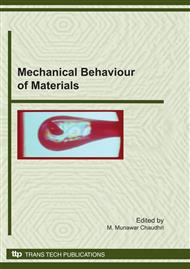p.1
p.13
p.27
p.39
p.53
p.77
p.85
p.95
The Effect of Solid Solution Impurities on Dislocation Nucleation in a (001) Mo – 1.5 at.% Ir Single Crystal
Abstract:
Mechanical properties of (001) Mo and (001) Mo – 1.5 at.% Ir single crystals have been studied by nanoindentation. It has been found that the iridium addition to molybdenum leads to an increase in both hardness and elastic modulus. An abrupt elasto-plastic transition (pop-in) at a depth of about 20 - 40 nm caused by dislocation nucleation in previously dislocation-free volume has been observed in the initial portion of the loading curve. It has shown that the Ir addition essentially affects the dislocation nucleation. Mean shear stress required for the dislocation nucleation increased from 10.8 GPa (G/12) for a Mo single crystal to 18.2 GPa (G/8) for the Mo – 1.5 at% Ir solid solution. Thus, the Ir solution in a Mo single crystal affects not only the resistance to the motion of dislocations (hardness) but the nucleation of them as well. The latter is likely to occur as a result of an increase in the structure perfection of the Mo – 1.5 at% Ir solid solution as compared to the pure Mo single crystal.
Info:
Periodical:
Pages:
85-93
Citation:
Online since:
November 2010
Authors:
Price:
Сopyright:
© 2011 Trans Tech Publications Ltd. All Rights Reserved
Share:
Citation:


